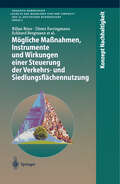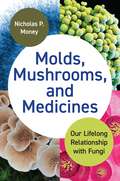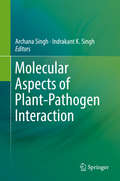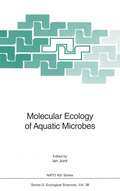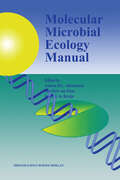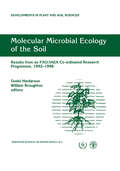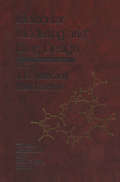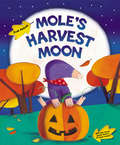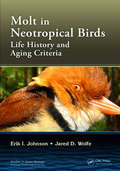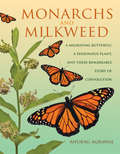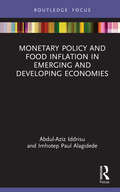- Table View
- List View
Mögliche Maßnahmen, Instrumente und Wirkungen einer Steuerung der Verkehrs- und Siedlungsflächennutzung (Konzept Nachhaltigkeit)
by Kilian Bizer Dieter Ewringmann Eckhard Bergmann Fabian Dosch Klaus Einig Gerard HutterDie Enquete-Kommission "Schutz des Menschen und der Umwelt" hat mit den ehrgeizigen Zielen, die Flächenausweisung bis 2010 auf 10 v. H. der Anfang der neunziger Jahre bestehenden Ausweisung zu reduzieren, sowie die Versiegelung auf dem jetzigen Stand einzufrieren, neue Maßstäbe für den Umgang mit Flächen gesetzt. Die vorliegende Studie beschäftigt sich mit drei möglichen Instrumenten, diese Ziele zumindest ansatzweise umzusetzen. Die drei Instrumente sind handelbare Flächenausweisungsrechte, ein modifizierter kommunaler Finanzausgleich und eine als Flächennutzungsteuer reformierte Grundsteuer.
Molds, Mushrooms, and Medicines: Our Lifelong Relationship with Fungi
by Nicholas P. MoneyThe hidden role of fungi inside and all around usFrom beneficial yeasts that aid digestion to toxic molds that cause disease, we are constantly navigating a world filled with fungi. Molds, Mushrooms, and Medicines explores the amazing ways fungi interact with our bodies, showing how our health and well-being depend on an immense ecosystem of yeasts and molds inside and all around us.Nicholas Money takes readers on a guided tour of a marvelous unseen realm, describing how our immune systems are engaged in continuous conversation with the teeming mycobiome inside the body, and how we can fall prey to serious and even life-threatening infections when this peaceful coexistence is disturbed. He also sheds light on our complicated relationship with fungi outside the body, from wild mushrooms and cultivated molds that have been staples of the human diet for millennia to the controversial experimentation with magic mushrooms in the treatment of depression.Drawing on the latest advances in mycology, Molds, Mushrooms, and Medicines reveals what scientists are learning about the importance of fungi to our lives, from their vital role in supporting the ecosystems on which we depend to their emerging uses in lifesaving medicine.
Molds, Mushrooms, and Medicines: Our Lifelong Relationship with Fungi
by Nicholas P. MoneyThe hidden role of fungi inside and all around usFrom beneficial yeasts that aid digestion to toxic molds that cause disease, we are constantly navigating a world filled with fungi. Molds, Mushrooms, and Medicines explores the amazing ways fungi interact with our bodies, showing how our health and well-being depend on an immense ecosystem of yeasts and molds inside and all around us.Nicholas Money takes readers on a guided tour of a marvelous unseen realm, describing how our immune systems are engaged in continuous conversation with the teeming mycobiome inside the body, and how we can fall prey to serious and even life-threatening infections when this peaceful coexistence is disturbed. He also sheds light on our complicated relationship with fungi outside the body, from wild mushrooms and cultivated molds that have been staples of the human diet for millennia to the controversial experimentation with magic mushrooms in the treatment of depression.Drawing on the latest advances in mycology, Molds, Mushrooms, and Medicines reveals what scientists are learning about the importance of fungi to our lives, from their vital role in supporting the ecosystems on which we depend to their emerging uses in lifesaving medicine.
Molecular Aspects of Plant-Pathogen Interaction
by Archana Singh Indrakant K. SinghThe book offers an integrated overview of plant–pathogen interactions. It discusses all the steps in the pathway, from the microbe–host-cell interface and the plant’s recognition of the microbe to the plant’s defense response and biochemical alterations to achieve tolerance / resistance. It also sheds light on the classes of pathogens (bacteria, fungus and viruses); effector molecules, such as PAMPs; receptor molecules like PRRs and NBS-LRR proteins; signaling components like MAPKs; regulatory molecules, such as phytohormones and miRNA; transcription factors, such as WRKY; defense-related proteins such as PR-proteins; and defensive metabolites like secondary metabolites. In addition, it examines the role of post-genomics, high-throughput technology (transcriptomics and proteomics) in studying pathogen outbreaks causing crop losses in a number of plants. Providing a comprehensive picture of plant-pathogen interaction, the updated information included in this book is valuable for all those involved in crop improvement.
Molecular Biology of Woody Plants: Volume 2 (Forestry Sciences #66)
by S. M. Jain S. C. MinochaWoody plants belong to various taxonomic groups, which are heterogeneous in morphology, physiology, and geographic distribution. OtheJWise, they have neither strong evolutionruy relationships nor share a conunon habitat. They are a primaIy source of fiber and timber, and also include many edible fruit species. Their unique phenotypic behavior includes a perennial habit associated with extensive secondary growth. Additional characteristics of woody plants include: developmental juvenility and maturity with respect to growth habit, flowering time, and morphogenetic response in tissue cultures; environmental control of bud dormancy and flowering cycles; variable tolerance to abiotic stresses, wounding and pathogens; and long distance transport of water and IRltrients. Woody plants, particularly tree species, have been the focus of numerous physiological studies to understand their specialized functions, however, only recently they have become the target of molecular studies. Recent advances in our understanding of signal transduction pathways for environmental responses in herbaceous plants, including the identification and cloning of genes for proteins involved in signal transduction. should provide useful leads to undertake parallel studies with woody plants. Molecular mapping techniques, coupled with the availability of cloned genes from herbaceous plants, should provide shortcuts to cloning relevant genes from woody plants. The unique phenotypes of these plants can then be targeted for improvement through genetic engineering.
Molecular Biology of Woody Plants: Volume 1 (Forestry Sciences #64)
by S. M. Jain S. C. MinochaThis two-volume book gives a broad coverage of various aspects of plant molecular biology relevant to the improvement of woody plants. The authors provide background information on genetic engineering and molecular marker techniques, and specific examples of species in which sufficient progress has been made.
Molecular Diversity of Environmental Prokaryotes
by Thiago Bruce Rodrigues Amaro Emiliano SilvaThis book correlates the vast genetic diversity associated with environmental samples and still underexploited potential for the development of biotechnology products. The book points out the potential of different types of environmental samples. It presents the main characteristics of microbial diversity, the main approaches used for molecular characterization of the diversity, and practical examples of application of the exploration of the microbial diversity. It presents a not-yet-explored structure for discussing the main topics related to molecular biology of environmental prokaryotes and their biotechnological applications.
Molecular Diversity of Environmental Prokaryotes
by Thiago Bruce Rodrigues and Amaro Emiliano Trindade SilvaThis book correlates the vast genetic diversity associated with environmental samples and still underexploited potential for the development of biotechnology products. The book points out the potential of different types of environmental samples. It presents the main characteristics of microbial diversity, the main approaches used for molecular characterization of the diversity, and practical examples of application of the exploration of the microbial diversity. It presents a not-yet-explored structure for discussing the main topics related to molecular biology of environmental prokaryotes and their biotechnological applications.
Molecular Ecology and Conservation Genetics of Neotropical Mammals
by Maximiliano Nardelli Juan Ignacio TúnezAlthough all living beings modify their environment, human beings have acquired the ability to do so on a superlative space-time scale. As a result of industrialization and the use of new technologies, the anthropogenic impact has been increasing in the last centuries, causing reductions in the sizes or the extinction of numerous wild populations. In this sense, from the field of conservation genetics, various efforts have been made in recent decades to provide new knowledge that contributes to the conservation of populations, species, and habitats. In this book, we summarize the concrete contributions of researchers to the conservation of the Neotropical mammals using Molecular Ecology techniques.The book is divided into three major sections. The first section provides an up-to-date review of the conservation status of Neotropical mammals, the applications of the molecular markers in its conservation, and the use of non-invasive and forensic genetic techniques. The second and third sections present, respectively, a series of case studies in various species or taxonomic groups of Neotropical mammals.
Molecular Ecology of Aquatic Microbes (Nato ASI Subseries G: #38)
by Ian JointA NATO ASI on "Molecular Ecology of Aquatic Microbes" was held at II Ciocco, Lucca, Italy from 28 August - 9 September 1994. The aims of the ASI were to evaluate the potential for molecular biology to solve some important questions in aquatic microbiology, particularly in relation to biogeochemical cycling and microbial physiology. Techniques developed by molecular biologists have now been adopted by a wide range of scientific disciplines. In the last 5 years, aquatic microbial ecologists have begun to incorporate these methods into their research and, as a result, are developing a much clearer understanding of phylogenetic diversity, the molecular basis of physiological acclimations and the transduction of environmental signals and organism responses. The aim of this ASI was to assess progress in this new field of research, to compare and describe techniques and experimental approaches, and to foster communication between disciplines. The ASI offered an excellent opportunity to bring together aquatic ecologists with molecular biologists and to encourage efficient technology transfer. The meeting of information on the status provided a forum for detailed and broad exchange and trends of aquatic molecular ecology and to assess how emerging molecular techniques might solve some important problems in ecology which have prove intractable because of lack of appropriate methodologies.
Molecular Mechanisms of Plant and Microbe Coexistence (Soil Biology #15)
by V. L. Chopra Chandra Shekhar Nautiyal Patrice DionMolecular Mechanisms of Plant and Microbe Coexistence presents studies on the complex and manifold interactions of plants and microbes at the population, genomics and proteomics level. The role of soil microbial diversity in enhancing plant health and plant microbe beneficial symbioses is discussed. Microbial communities are shown in the light of evolution. Main topics include genome coexistence and the functional genomics and proteomics of plant-associated microbes, which could form the basis for new environmentally benign strategies to combat infectious plant diseases and regulate plant growth. Further chapters focus on the role of signaling during the different stages of plant microbe coexistence, in symbiotic or pathogenic relationships, in quorum sensing and plant viral infections. Methods for studying the interactions in the root zone complement the book, which will certainly be of relevance in the practical application to agriculture, food security and for maintaining the balance of our ecosystems.
Molecular Microbial Ecology Manual
by A. D. Akkermans Jan Dirk Van Elsas F. J. De BruijnFor a long time microbial ecology has been developed as a distinct field with in Ecology. In spite of the important role of microorganisms in the environ ment, this group of 'invisible' organisms remained unaccessable to other ecologists. Detection and identification of microorganisms remain largely dependent on isolation techniques and characterisation of pure cultures. We now realise that only a minor fraction of the microbial community can be cultivated. As a result of the introduction of molecular methods, microbes can now be detected and identified at the DNA/RNA level in their natural environment. This has opened a new field in ecology: Molecular Microbial Ecology. In the present manual we aim to introduce the microbial ecologist to a selected number of current molecular techniques that are relevant in micro bial ecology. The first edition of the manual contains 33 chapters and an equal number of additional chapters will be added this year. Since the field of molecular ecology is in a continuous progress, we aim to update and extend the Manual regularly and will invite anyone to deposit their new protocols in full detail in the next edition of this Manual.
Molecular Microbial Ecology of the Soil: Results from an FAO/IAEA Co-ordinated Research Programme, 1992–1996 (Developments in Plant and Soil Sciences #83)
by Gudni G. Hardarson William J. BroughtonMolecular Modelling and Drug Design (Topics in Molecular and Structural Biology)
The place of molecular modelling in drug design is now firmly established. Molecular Modelling and Drug Design contains chapters from among the best young scientists in industry and academia. They present many of the new methods available as well as describing the correct use of more established techniques. The book has been written with a blend of optimism, including methods designed to semi - automate a large part of the drug design process, and pragmatism, pointing out the traps into which the unwary researcher may be drawn. Essential reading both for the modelling practitioner, and for those whose research would benefit from an understanding of the broad range of applications of molecular modelling.
Molecular Tools for Screening Biodiversity: Plants and Animals
by A. Karp D. S. Ingram Peter G. IsaacMark Chase There are many literature resources available to molecular biologists wishing to assess genetic variation, but the myriad of techniques and approaches potentially available to the plant breeder and the evolutionary biologist is truly bewildering, and most have never been evaluated side-by-side on the same sets of samples. Additionally, it is often not recognized that tools that are useful for breeders can often be adapted for use in evolutionary studies and vice versa, but this is generally the case. The borderline between population genetics and phylogenetics is vague and difficult to assess, and a combination of both types of tools is best when it is not clear with which area one is dealing. Furthermore, it is not now appropriate to use just one type of marker in any kind of study; most markers have the potential to misinform under certain conditions, so it is always wise to incorporate at least two different types of assessments into any project. This volume is designed to facilitate this sort of multiple approach and provides comparative data on most currently available methods so that researchers can more intelligently select those appropriate to their area of interest, regardless of whether it is in the realm of breeding or evolutionary biology.
Mole's Harvest Moon
by Judi AbbotBear, Mouse and Rabbit are foraging for ingredients for Mole's harvest feast. But as darkness falls they realise they are being followed! Only the light of the harvest moon and their own cunning will get them home - but on this spooky autumn night is everything as it seems?A lovely reassuring autumnal tale about appearances, food and friendship.
Molluscan Communities of the Florida Keys and Adjacent Areas: Their Ecology and Biodiversity
by Edward J. Petuch Robert F. MyersMolluscan Communities of the Florida Keys and Adjacent Areas: Their Ecology and Biodiversity is the first comprehensive overview of the ecology and biodiversity of the phylum Mollusca in the area of Florida extending from the Dry Tortugas and Ten Thousand Islands in the west to Palm Beach in the east. The book provides detailed analyses of mollusca
Mollusks and Marine Environments of the Ten Thousand Islands
by Edward J. Petuch David P. BerschauerMollusks and Marine Environments of the Ten Thousand Islands provides the first comprehensive overview of the shells and habitats that are present in the last unexplored coastal area of southwestern Florida. The mysterious and primordial Ten Thousand Islands, where the rivers and marshlands of the Everglades empty into the Gulf of Mexico, house a number of remarkable marine ecosystems, many shown here in detail for the first time. Primary among these are unique worm shell “reef systems,” composed entirely of immense masses of vermetid gastropod mollusks. These previously unexplored and unstudied gastropod reefs, which are often many acres in size, are shown here to mimic coral reefs in their growth structure and represent the only large-scale molluscan reefs found anywhere on Earth. Living in association with the zonated gastropod reefs are a number of rare and unusual mollusks, some of which represent endemic species that are unique to the Ten Thousand Islands. These and many other southwestern Florida shells are illustrated throughout this book, along with detailed illustrations and descriptions of the marine and estuarine environments that dominate the archipelago and its adjacent lagoon systems.
Mollusks and Marine Environments of the Ten Thousand Islands
by Edward J. Petuch David P. BerschauerMollusks and Marine Environments of the Ten Thousand Islands provides the first comprehensive overview of the shells and habitats that are present in the last unexplored coastal area of southwestern Florida. The mysterious and primordial Ten Thousand Islands, where the rivers and marshlands of the Everglades empty into the Gulf of Mexico, house a number of remarkable marine ecosystems, many shown here in detail for the first time. Primary among these are unique worm shell “reef systems,” composed entirely of immense masses of vermetid gastropod mollusks. These previously unexplored and unstudied gastropod reefs, which are often many acres in size, are shown here to mimic coral reefs in their growth structure and represent the only large-scale molluscan reefs found anywhere on Earth. Living in association with the zonated gastropod reefs are a number of rare and unusual mollusks, some of which represent endemic species that are unique to the Ten Thousand Islands. These and many other southwestern Florida shells are illustrated throughout this book, along with detailed illustrations and descriptions of the marine and estuarine environments that dominate the archipelago and its adjacent lagoon systems.
Molt in Neotropical Birds: Life History and Aging Criteria (Studies in Avian Biology)
by Erik I. Johnson Jared D. WolfeMolt is an important avian life history event in which feathers are shed and replaced. The timing, duration, seasonality, extent and pattern of molt follows certain strategies and this book reviews and describes these strategies for nearly 190 species based on information gathered from a 30-year study of Central Amazonian birds. Most species accounts are illustrated with several color photos focusing on wing and tail feather molt, molt limits, and how to use these patterns to accurately age birds. Published in collaboration with and on behalf of the American Ornithological Society, this volume in the highly-regarded Studies in Avian Biology series is a rich source of life history information for ornithologists working on tropical birds.
Molt in Neotropical Birds: Life History and Aging Criteria (Studies in Avian Biology)
by Erik I. Johnson Jared D. WolfeMolt is an important avian life history event in which feathers are shed and replaced. The timing, duration, seasonality, extent and pattern of molt follows certain strategies and this book reviews and describes these strategies for nearly 190 species based on information gathered from a 30-year study of Central Amazonian birds. Most species accounts are illustrated with several color photos focusing on wing and tail feather molt, molt limits, and how to use these patterns to accurately age birds. Published in collaboration with and on behalf of the American Ornithological Society, this volume in the highly-regarded Studies in Avian Biology series is a rich source of life history information for ornithologists working on tropical birds.
Monarchs and Milkweed: A Migrating Butterfly, a Poisonous Plant, and Their Remarkable Story of Coevolution
by Anurag AgrawalThe fascinating and complex evolutionary relationship of the monarch butterfly and the milkweed plantMonarch butterflies are one of nature's most recognizable creatures, known for their bright colors and epic annual migration from the United States and Canada to Mexico. Yet there is much more to the monarch than its distinctive presence and mythic journeying. In Monarchs and Milkweed, Anurag Agrawal presents a vivid investigation into how the monarch butterfly has evolved closely alongside the milkweed—a toxic plant named for the sticky white substance emitted when its leaves are damaged—and how this inextricable and intimate relationship has been like an arms race over the millennia, a battle of exploitation and defense between two fascinating species.The monarch life cycle begins each spring when it deposits eggs on milkweed leaves. But this dependency of monarchs on milkweeds as food is not reciprocated, and milkweeds do all they can to poison or thwart the young monarchs. Agrawal delves into major scientific discoveries, including his own pioneering research, and traces how plant poisons have not only shaped monarch-milkweed interactions but have also been culturally important for centuries. Agrawal presents current ideas regarding the recent decline in monarch populations, including habitat destruction, increased winter storms, and lack of milkweed—the last one a theory that the author rejects. He evaluates the current sustainability of monarchs and reveals a novel explanation for their plummeting numbers.Lavishly illustrated with more than eighty color photos and images, Monarchs and Milkweed takes readers on an unforgettable exploration of one of nature's most important and sophisticated evolutionary relationships.
Monarchs and Milkweed: A Migrating Butterfly, a Poisonous Plant, and Their Remarkable Story of Coevolution
by Anurag AgrawalThe fascinating and complex evolutionary relationship of the monarch butterfly and the milkweed plantMonarch butterflies are one of nature's most recognizable creatures, known for their bright colors and epic annual migration from the United States and Canada to Mexico. Yet there is much more to the monarch than its distinctive presence and mythic journeying. In Monarchs and Milkweed, Anurag Agrawal presents a vivid investigation into how the monarch butterfly has evolved closely alongside the milkweed—a toxic plant named for the sticky white substance emitted when its leaves are damaged—and how this inextricable and intimate relationship has been like an arms race over the millennia, a battle of exploitation and defense between two fascinating species.The monarch life cycle begins each spring when it deposits eggs on milkweed leaves. But this dependency of monarchs on milkweeds as food is not reciprocated, and milkweeds do all they can to poison or thwart the young monarchs. Agrawal delves into major scientific discoveries, including his own pioneering research, and traces how plant poisons have not only shaped monarch-milkweed interactions but have also been culturally important for centuries. Agrawal presents current ideas regarding the recent decline in monarch populations, including habitat destruction, increased winter storms, and lack of milkweed—the last one a theory that the author rejects. He evaluates the current sustainability of monarchs and reveals a novel explanation for their plummeting numbers.Lavishly illustrated with more than eighty color photos and images, Monarchs and Milkweed takes readers on an unforgettable exploration of one of nature's most important and sophisticated evolutionary relationships.
Monetary Policy and Food Inflation in Emerging and Developing Economies (Routledge Focus on Environment and Sustainability)
by Abdul-Aziz Iddrisu Imhotep Paul AlagidedeThis book focuses on the impact of monetary policy and food price volatility and inflation in emerging and developing economies. The tendency for food price volatility to blot inflation forecasting accuracy, engender tail dynamics in the overall inflation trajectory and derail economic welfare is well known in the literature. The ability of monetary policy to exact stability in food prices, theoretically, has also been well espoused. The empirical evidence, however, is not only in short supply, but also the studies available have dwelt on approaches that underplay the volatile behaviour of food prices. This book focuses on inflation targeting in emerging economies such as Chile, Mexico, Turkey, Brazil, Hungary, Russia, Colombia, South Africa, Indonesia and Ghana, as these are economies with considerable proportion of the consumption basket occupied by food. The book provides the means to understand at first hand the correct way to model food inflation, account for the related policy responses to deviations either in the short or medium to long term, and in market conditions that are subject to excessive variability. Strong evidence is presented that captures deviations of food prices from their trend and the accompanying monetary policy effect in stabilizing such variabilities across distinct frequencies. The novel approach in this book addresses the burgeoning puzzles of asymmetry in monetary policy effect on food prices at high, medium and low episodes of food inflation. In doing so, this book presents a powerful tool for researchers interested in understanding not just the transmission mechanism, but also the magnitudes involved, and to policymakers whose existing tools have failed them. Future studies will do well to deepen the evidence and seek new grounds to which the phenomenon manifests beyond and below emerging markets. This book will be of great interest to students, scholars and policymakers involved in agricultural economics, financial economics, food security and sustainable development.
Monetary Policy and Food Inflation in Emerging and Developing Economies (Routledge Focus on Environment and Sustainability)
by Abdul-Aziz Iddrisu Imhotep Paul AlagidedeThis book focuses on the impact of monetary policy and food price volatility and inflation in emerging and developing economies. The tendency for food price volatility to blot inflation forecasting accuracy, engender tail dynamics in the overall inflation trajectory and derail economic welfare is well known in the literature. The ability of monetary policy to exact stability in food prices, theoretically, has also been well espoused. The empirical evidence, however, is not only in short supply, but also the studies available have dwelt on approaches that underplay the volatile behaviour of food prices. This book focuses on inflation targeting in emerging economies such as Chile, Mexico, Turkey, Brazil, Hungary, Russia, Colombia, South Africa, Indonesia and Ghana, as these are economies with considerable proportion of the consumption basket occupied by food. The book provides the means to understand at first hand the correct way to model food inflation, account for the related policy responses to deviations either in the short or medium to long term, and in market conditions that are subject to excessive variability. Strong evidence is presented that captures deviations of food prices from their trend and the accompanying monetary policy effect in stabilizing such variabilities across distinct frequencies. The novel approach in this book addresses the burgeoning puzzles of asymmetry in monetary policy effect on food prices at high, medium and low episodes of food inflation. In doing so, this book presents a powerful tool for researchers interested in understanding not just the transmission mechanism, but also the magnitudes involved, and to policymakers whose existing tools have failed them. Future studies will do well to deepen the evidence and seek new grounds to which the phenomenon manifests beyond and below emerging markets. This book will be of great interest to students, scholars and policymakers involved in agricultural economics, financial economics, food security and sustainable development.
